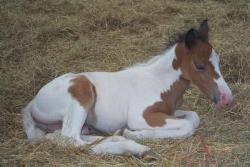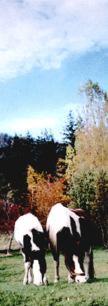 |
The
Chincoteague Pony |
The ponies live on the islands of Chincoteague and Assateague off the coast of Virginia and Maryland. The Ponies are a race of small hardy horses, compact and good natured. The legend is that these ponies swam ashore from a Spanish Vessel which had capsized off the coast, around the century 1600. Once on the islands they became stunted under the harsh environment. To keep from starving they ate coarse saltmarsh cordgrass, American beachgrass, thorny greenbrier stems, bayberry twigs, seaweed and even poison ivy. Because they drink salt water, they have an appearance of being "fat" or "bloated". The horses bred down to the unique breed we know today as the Chincoteague Pony.
 |
Today there
are two groups of these ponies descended down from the only 17 original Arabian
Horses in which survived the famous shipwreck. The two groups are "The
Maryland Herd" and "The Virginia Herd". The Virginia Herd
consists of approximately 130 head and is owned by the Chincoteague Volunteer
Fire Dept. The ponies graze in the Chincoteague National Wildlife Refuge,
located on the Virginia portion of Assateague Island. The Maryland Herd
consists of approximately 40 Head and is owned by the Maryland Park
Service. The famous annual "Pony Round-up" and "Pony Swim" is held each year during the month of July. The Chincoteague Volunteer Fireman herd the ponies off their island at slack tide, through the sea water channel to Virginia. On the last Wednesday of every July, the ponies are gathered for the sale the next day. Here the baby foals are auctioned off to the highest bidder. In 1998, the highest bid ever for a pony was $7000 |
After the Chincoteague Pony foals are sold, the stallions and mares are taken back to their islands, again swimming the channel at slack tide. Slack tide is when the water is at it's calmest and the tide is neither coming in nor going out. This is the easiest time for the ponies to cross the channel.
| There are approximately 180 privately owned Chincoteague Ponies scattered over the United States and Canada. In the mid 80's Gale Park Frederick founded a horse registry for the Chincoteague Ponies. They are now recognized as a pure and rare breed. |  |
Aptitudes,Notable Physical
Temperamental Characteristics
 |
COLOR: Mostly pintoPalamino-Bay on white. Solids too: Black and Sorrels |
CONFORMATION: Well proportioned.Strong and Muscular. Standing 14 hands and under. Extra Thick mane and tail. |
 |
 |
DISPOSITION: Good natured kind, sweet and gentleHighly intelligent and versatile. |
TRAITS:
Today off the islands the ponies are
"easy keepers". The Chincoteague Pony requires little food compared
to a adult horse. They will do nicely in a weed patch, plus hay, a salt block,
grain and fresh water.
There is a saying " A Chincoteague Pony can get fat on a cement
slab".
During the Winter months, the ponies will grow a heavy coat of hair. They will
become shaggy in appearance.
 |
Despite their feral beginnings
off the Virginia Coast, the Chincoteague Pony has become a breed well suited
for domestic life. Considered an exceptional children's mount, the Chincoteague
Pony performs well in hunt seat, jumping, driving (with small carts, of course)
and trail riding, under English or western saddle. The breed's often colorfully
marked coat also makes it a particular favorite in pony halter classes, where
its unique style and balanced conformation can be shown to the breed's greatest
advantage. |
| The information and
illustrations for this article are kindly provided by the National Chincoteague
Pony Association. For further information on the ponies please contact the The National Chincoteague Pony Association E-mail: GFreder426@aol.com Website: www.pony-chincoteague.com |
 |